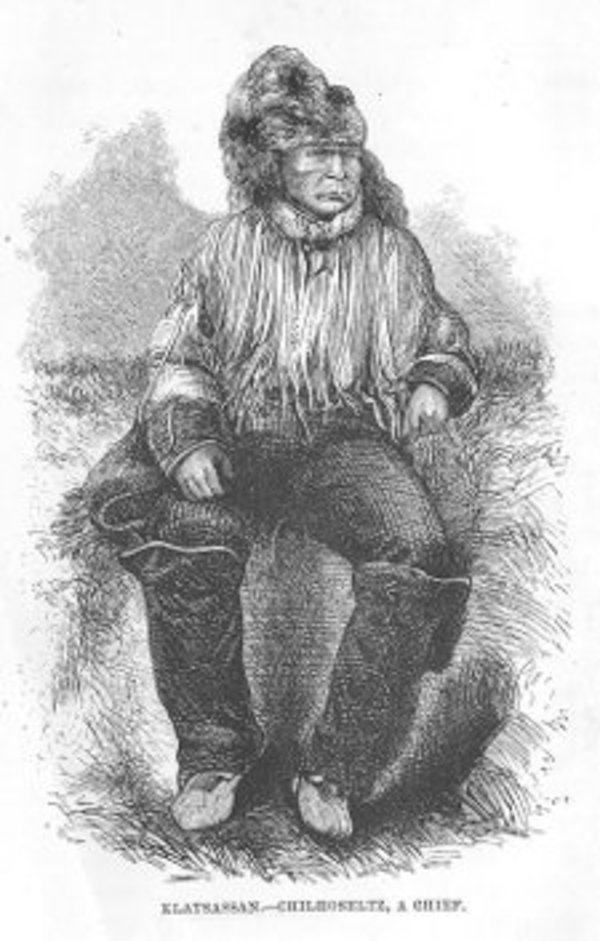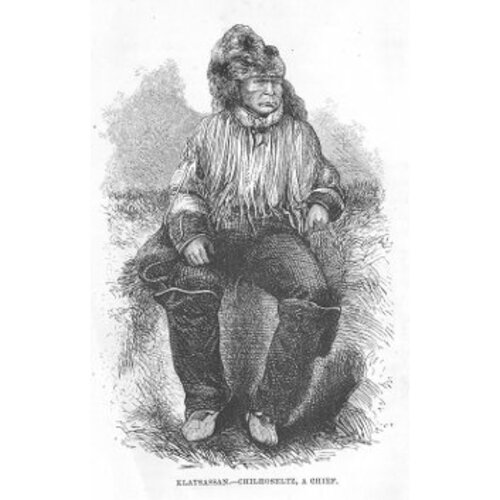
Source: Link
KLATSASSIN (Klatsassan, Klattasine), Chilcotin chief; executed 26 Oct. 1864 at Quesnellemouth (Quesnel), B.C., and was apparently survived by two wives and several children.
The Chilcotins were a semi-nomadic hunting and fishing tribe of British Columbia inhabiting most of the Chilcotin River drainage basin and some adjoining territory. They had long and hostile relationships with some adjacent tribes – the Carriers and Lillooets, and some of the Shuswaps – but were in the main friendly with the Bella Coolas and the Canyon Shuswaps. Their social structure was loose, and their sense of unity as a tribe weak. The nature of leadership among the Chilcotins is not clear, but it is apparent that although it could be informal the hereditary principle also played a part, at least in the period following contact with whites.
The Chilcotins’ relationships with white furtraders before the years of the gold rush had been strained, and most had experienced only superficial contacts with missionaries. In 1862 a smallpox epidemic wiped out probably one-half to two-thirds of the tribe. In that year also Alfred Waddington* began work on a trail inland from Bute Inlet to run through Chilcotin territory. Many Chilcotins were attracted to the coast to work as packers for the construction crews.
In the spring of 1864 some goods left at Bute Inlet were discovered to have been stolen. A white man questioned a group of Chilcotins regarding the theft. Receiving no satisfaction, he took down their names, then told them that they would all die. The Chilcotins, who believed that it was possible to bring harm to others through spirits, doubtless thought that the white man had acquired a power of life and death over them through what seemed powerful magic, the writing down of their names. Their earlier experience of smallpox added to the effect of the threat as not long before smallpox had reached them in 1862 a white man was said to have threatened to bring it on them. His statement may have been merely a prediction rather than a threat, but it and the epidemic that followed had their effect on the Chilcotins when a threat really was made against them in the spring of 1864.
To the Chilcotins who had come to the Bute Inlet region, wiping out the whites seemed not only a revenge for the threat made there but also the only way to prevent the whites from bringing smallpox. This threat of smallpox was the chief immediate cause of the “Chilcotin Uprising” of 1864. Less direct causes were the Chilcotins’ previous experience with other tribes and with whites, and a desire for plunder.
One of the Chilcotin chiefs was Klatsassin, described as athletic and bold-looking, with a great under jaw. Although perhaps not a hereditary chief, he was nevertheless influential because of his physical vigour, intelligence, and commanding personality. On 29 April 1864 he and a number of other Chilcotins arrived at the ferry site about 30 miles up the Homathko River which led off Bute Inlet. Klatsassin shot the lone ferry-keeper, Tim Smith, and the Chilcotins plundered the stores, obtaining gunpowder and 30 pounds of balls.
About one mile above the ferry Klatsassin and his party met a Homathko Indian and the Chilcotin chief Telloot (Taloot, Tellot), who had come down to the Bute Inlet area in 1863 looking for work. Apparently Telloot had been employed by whites before and a written reference to his character said he was a “faithful and trustworthy guide.” The artist Frederick Whymper*, who had employed him as a guide in the Bute Inlet area in 1864, described Telloot as “an Indian of some intelligence.” He was a much older man than Klatsassin and an influential chief of a section of the tribe. Church of England clergyman R. C. Lundin Brown* later mentioned him as “a man of great authority with his tribe.”
Klatsassin told Telloot how he had killed the ferryman and after some argument Telloot joined Klatsassin. The Homathko who had accompanied Telloot hurried down-river, while Klatsassin, Telloot, and their party went up-river to the main road camp and there joined other members of their tribe. At dawn next morning (30 April) the Chilcotins attacked the 12 unsuspecting road-workers at the main camp. Only three escaped. Next the four workmen at the advance camp about two miles up-river were attacked; all perished. Proceeding into the interior to escape possible pursuit, Klatsassin and his followers (some 16 men and an undetermined number of women) reached Nancoontloon (Anahim) Lake where they were joined by more Chilcotins. They ambushed a pack-train; three whites were killed, but five escaped and reached Bentinck Arm. A settler at Puntzi Lake was also shot and his house looted, then destroyed.
Governor Frederick Seymour of British Columbia reacted swiftly. He sent an expedition under Police Magistrate Chartres Brew to the Homathko on 15 May, and another from Alexandria under Gold Commissioner William George Cox* which penetrated to Puntzi Lake. Brew returned to New Westminster and Seymour himself accompanied a second expedition under Brew which met Cox at Puntzi Lake on 6 July; both expeditions searched the country to the southwest. Cox later received several messages from Klatsassin and Telloot, and on 15 August they and six others came to Cox’s camp-site. Apparently they interpreted a message from Cox in reply as guaranteeing their freedom and their lives. Cox, however, regarded their coming as an outright surrender and was not ready to admit any such guarantee had been made.
The eight Indians were taken to Quesnellemouth. Two, having no specific charges against them, were freed; Chedékki, sent to New Westminster for trial, escaped on the way. Chief Justice Matthew Baillie Begbie* sentenced Klatsassin, Telloot, Tahpit, Chessus, and Piel (or Pierre, Klatsassin’s 18-year-old son) to be hanged. Lundin Brown acted as their spiritual counsellor. By means of an interpreter he instructed the prisoners in Christian teachings over many days. The Chilcotins had already been in either direct or indirect contact with Roman Catholic missionaries and at first, seeing that Brown had no crucifix about his neck, were somewhat dubious of his credentials as a true priest. But before the time of their execution they had accepted him and satisfied him as to their repentance and true faith.
A crowd of about 200 gathered to watch the execution on 26 October. Brief prayers were said in Chilcotin, Brown having now gained some knowledge of it, and, as each prisoner was blindfolded, he gave a blessing in their language. Tahpit suddenly called out to his fellow-prisoners to “have courage.” Then, addressing the Carrier Indians who had gathered, he said, “Tell the Chilcoatens to cease anger aginst the whites,” and added: “We are going to see the Great Father.”
Klatsassin’s role in almost every part of the Chilcotin uprising was a prominent one, and he was evidently the instigator and main planner. Without his forceful leadership it could not have been carried on for as long as it was. Yet the fact that he embarked on such a hopeless course shows how little he understood the position of his own people and the overwhelming strength of the white man.
PABC, Colonial correspondence, M. B. Begbie correspondence; Miscellaneous material relating to Fort Chilcotin, “Fort Chilcotin” (typescript). PAC, RG 7, G8, C, 26 April–20 Dec. 1865 (copies at University of British Columbia Library, Special Coll. Division). University of British Columbia Library, Special Coll. Division (Vancouver), Robie L. Reid papers, material on Alfred Waddington. Ross Cox, The Columbia River; or scenes and adventures during a residence of six years on the western side of the Rocky Mountains . . . , ed. E. I. and J. R. Stewart (Norman, Okla., 1957). Frederick Whymper, Travel and adventure in the territory of Alaska, formerly Russian America – now ceded to the United States – and in various other parts of the north Pacific (London, 1868).
British Columbian (New Westminster, B.C.), 28 May, 2 Nov. 1864. Daily British Colonist (Victoria), 15 Nov. 1862, 6 July 1863, 12 May 1864. Daily Press (Victoria), 4 Sept. 1862. Victoria Daily Chronicle, 12, 29 May 1864. R. C. L. Brown, Klatsassan, and other reminiscences of missionary life in British Columbia (London, 1873). R. B. Lane, “Cultural relations of the Chilcotin Indians of west central British Columbia” (unpublished phd thesis, University of Washington, Seattle, 1953). A.-G. Morice, The great Déné race (Vienna, n.d.); History of northern interior of B.C. (1904); History of the Catholic Church, II. E. S. Hewlett, “The Chilcotin uprising of 1864,” BC Studies, 19 (autumn 1973), 50–72. F. J. Saunders, “‘Homatcho’; or, the story of the Bute Inlet expedition, and the massacre by the Chilcoaten Indians,” Resources of British Columbia (Victoria), III (March 1885), 5–8; III (April 1885), 5–6.
Cite This Article
Edward Sleigh Hewlett, “KLATSASSIN (Klatsassan, Klattasine),” in Dictionary of Canadian Biography, vol. 9, University of Toronto/Université Laval, 2003–, accessed October 31, 2024, https://www.biographi.ca/en/bio/klatsassin_9E.html.
The citation above shows the format for footnotes and endnotes according to the Chicago manual of style (16th edition). Information to be used in other citation formats:
| Permalink: | https://www.biographi.ca/en/bio/klatsassin_9E.html |
| Author of Article: | Edward Sleigh Hewlett |
| Title of Article: | KLATSASSIN (Klatsassan, Klattasine) |
| Publication Name: | Dictionary of Canadian Biography, vol. 9 |
| Publisher: | University of Toronto/Université Laval |
| Year of publication: | 1976 |
| Year of revision: | 1976 |
| Access Date: | October 31, 2024 |



